通用小学英语小升初英语复习大全 课件 (共91张PPT)
文档属性
| 名称 | 通用小学英语小升初英语复习大全 课件 (共91张PPT) | 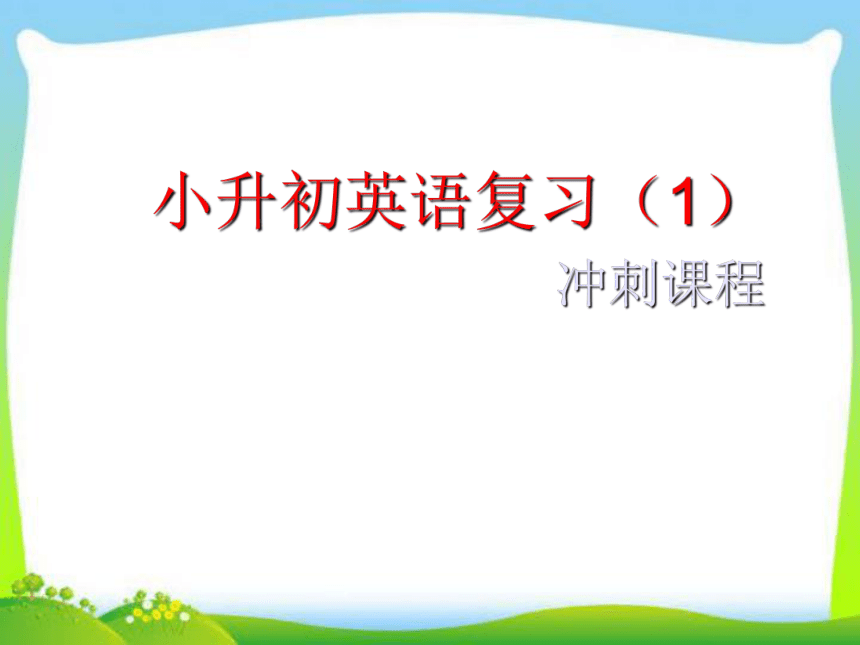 | |
| 格式 | zip | ||
| 文件大小 | 466.8KB | ||
| 资源类型 | 教案 | ||
| 版本资源 | 通用版 | ||
| 科目 | 英语 | ||
| 更新时间 | 2018-10-27 20:37:30 | ||
图片预览

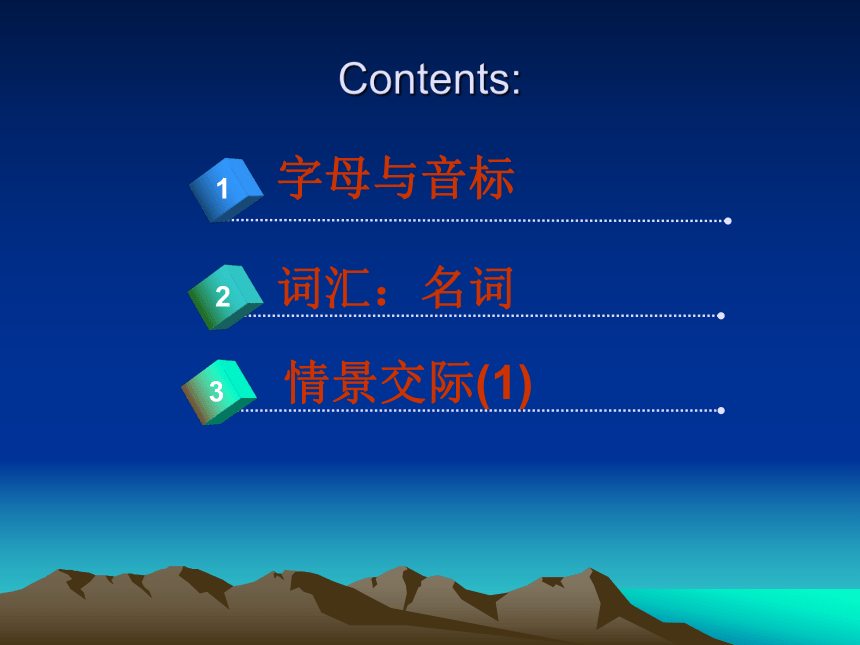
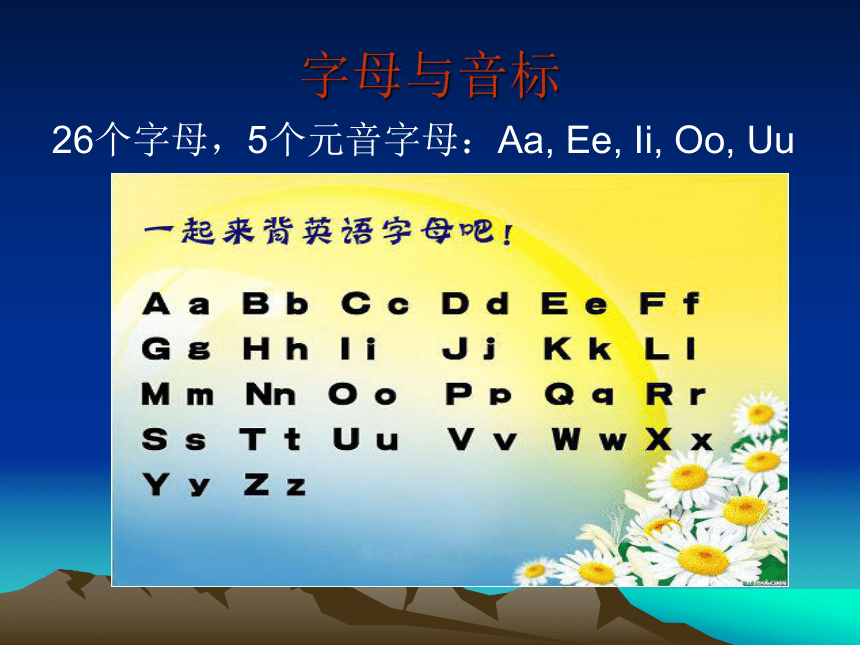
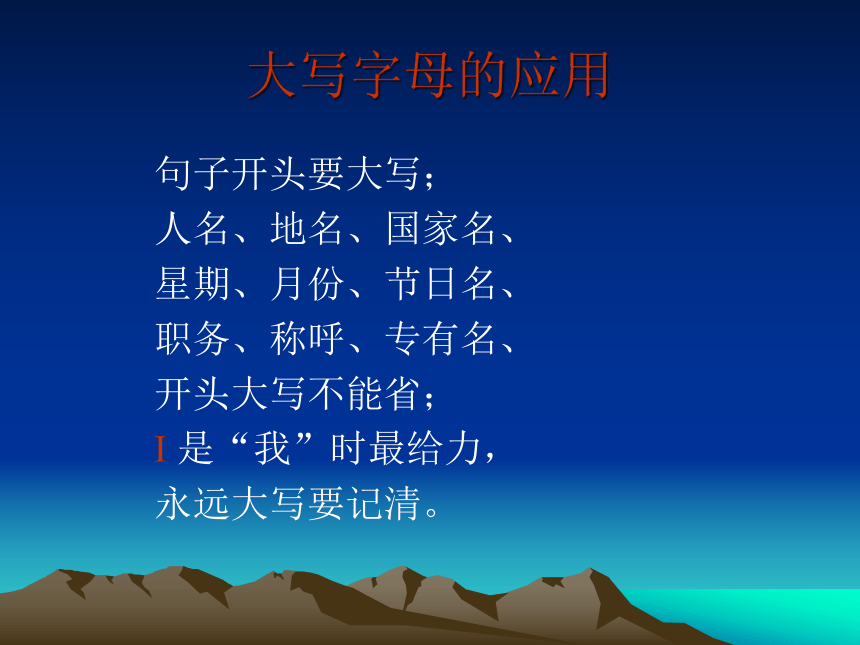
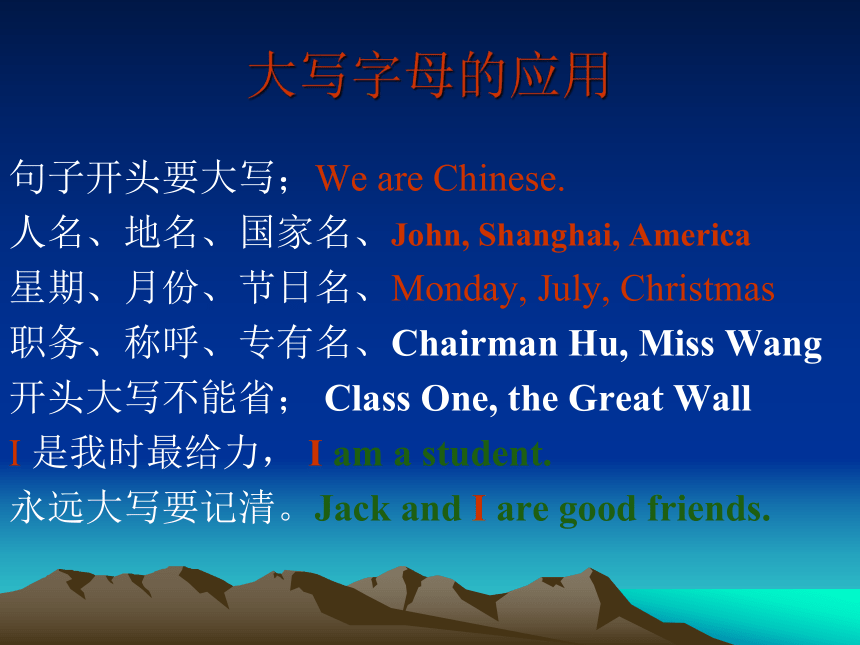
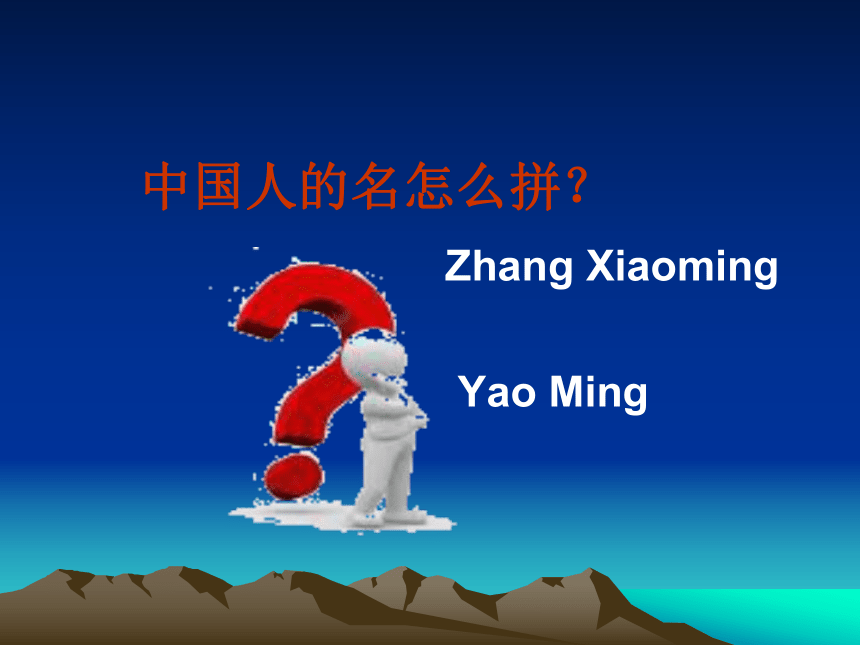
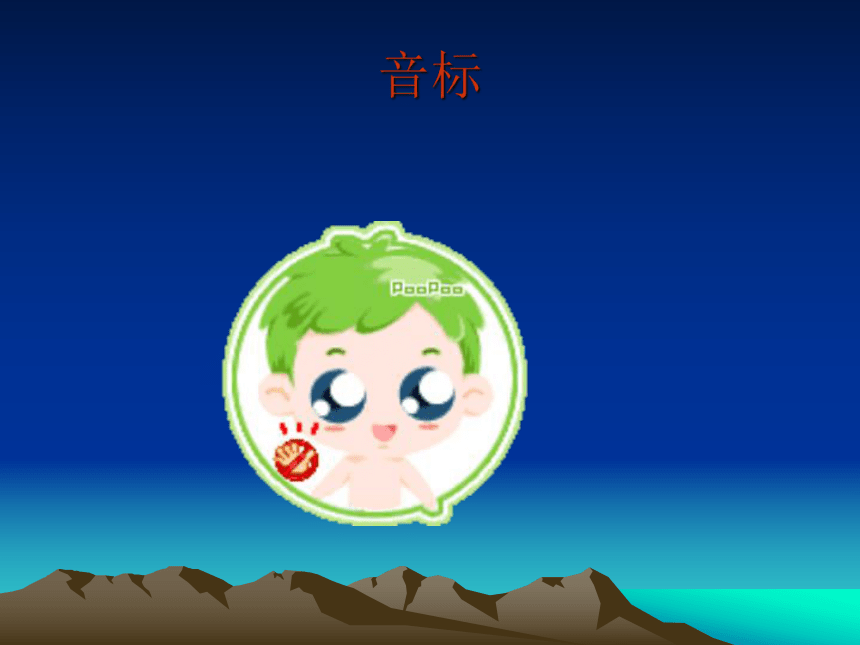
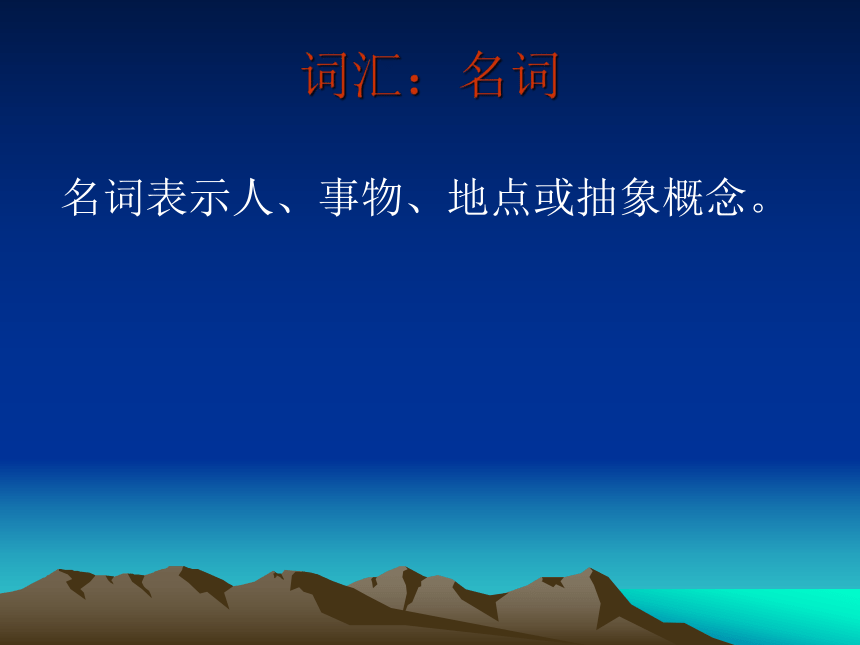
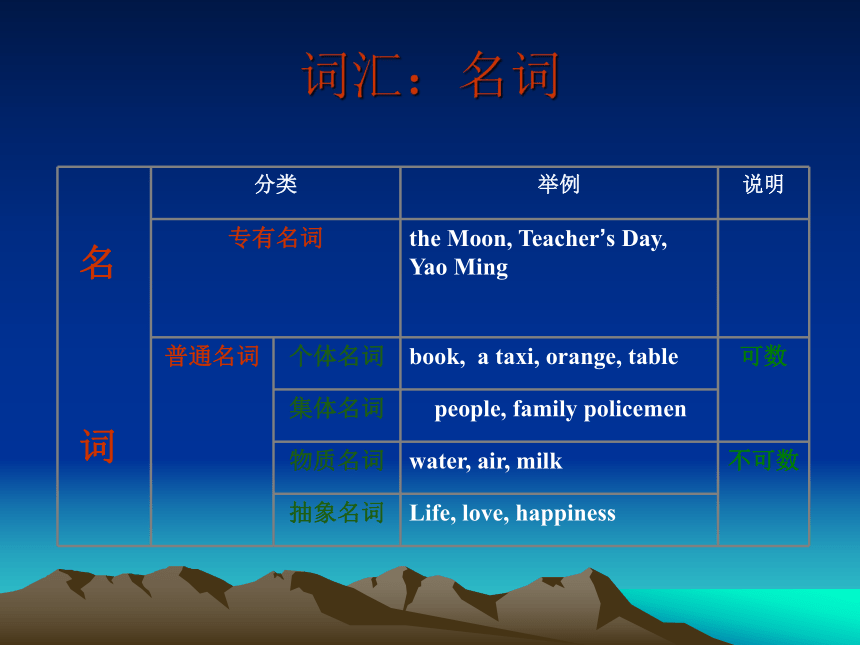
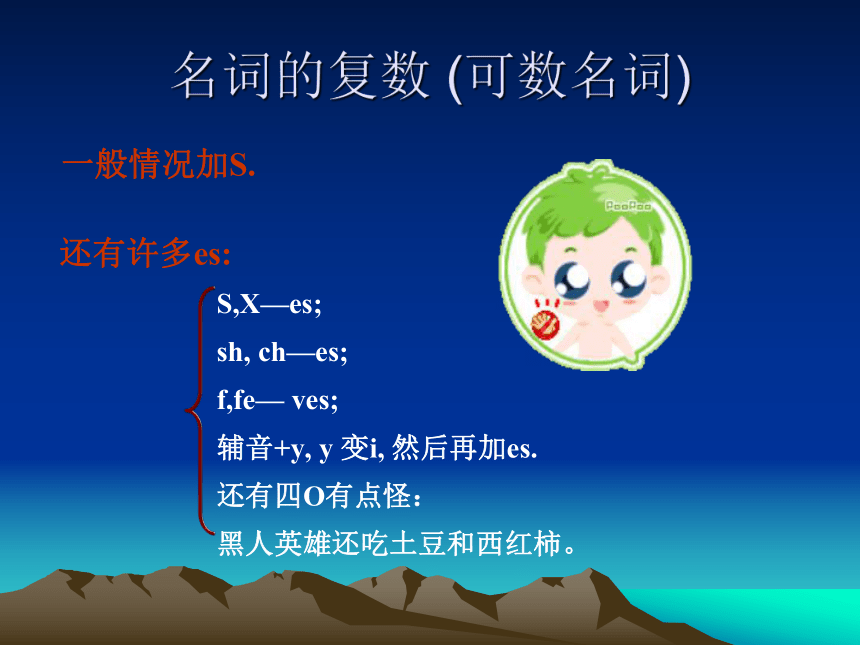
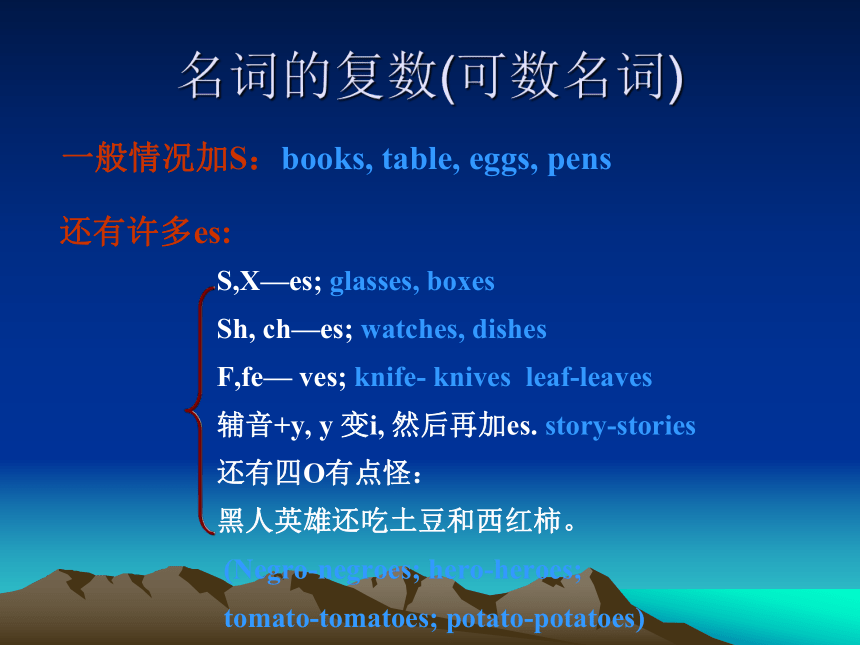
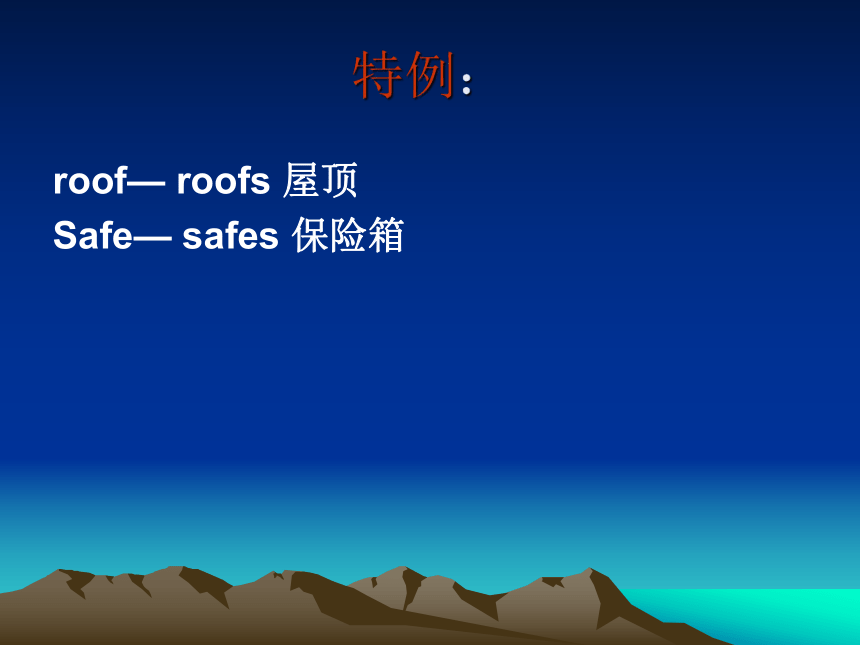
文档简介
课件91张PPT。 小升初英语复习(1)
冲刺课程 Contents: 123 词汇:名词情景交际(1)字母与音标字母与音标26个字母,5个元音字母:Aa, Ee, Ii, Oo, Uu
大写字母的应用句子开头要大写;
人名、地名、国家名、
星期、月份、节日名、
职务、称呼、专有名、
开头大写不能省;
I 是“我”时最给力,
永远大写要记清。大写字母的应用句子开头要大写;We are Chinese.
人名、地名、国家名、John, Shanghai, America
星期、月份、节日名、Monday, July, Christmas
职务、称呼、专有名、Chairman Hu, Miss Wang
开头大写不能省; Class One, the Great Wall
I 是我时最给力, I am a student.
永远大写要记清。Jack and I are good friends. 中国人的名怎么拼?
Zhang Xiaoming
Yao Ming音标词汇:名词
名词表示人、事物、地点或抽象概念。词汇:名词名词的复数 (可数名词) 一般情况加S.
还有许多es:
S,X—es;
sh, ch—es;
f,fe— ves;
辅音+y, y 变i, 然后再加es.
还有四O有点怪:
黑人英雄还吃土豆和西红柿。名词的复数(可数名词) 一般情况加S:books, table, eggs, pens
还有许多es:
S,X—es; glasses, boxes
Sh, ch—es; watches, dishes
F,fe— ves; knife- knives leaf-leaves
辅音+y, y 变i, 然后再加es. story-stories
还有四O有点怪:
黑人英雄还吃土豆和西红柿。
(Negro-negroes; hero-heroes;
tomato-tomatoes; potato-potatoes)特例:roof— roofs 屋顶
Safe— safes 保险箱
名词的复数(可数名词)名词复数形式的不规则变化
单复同形:羊遇路人(羊、鱼、鹿、中国人)
(sheep, fish, deer, Chinese)
OO变ee: 鹅的脚丫(牙)
(goose-geese, foot-feet,
tooth-teeth)
复作单: 新闻学科
news, maths, physics, politics
只有复: scissors, trousers, compasses, sunglass
元音变化:man-men, policeman-policemen不可数名词 不可以用数字数出来的名词叫不可数名词, 没有单复数之分。
a piece of paper
two cups of tea名词所有格名词中表示所有关系的形式叫名词所有格。
有两种构成方法:
名词+ Of + 名词
名词+ ’ s
名词所有格一般情况: 名+’S Tom’s book.
2. 词尾s或es结尾的名词+’
the teachers’ books, the kids’ apples
the students’ bags
3. 词尾不是S的名词复数+’S
the children’s toys, the women’s clothes
the men’s bikes名词所有格4. 表示各自的所有关系时,名词末尾均加+’S
Jim’s and Tom’s bedrooms
Andy’s and Susan’s mothers
5. 表示共同的所有关系时,在最后一个词后加’S
Andy and Susan’s mother
6. 表示无生命的东西的所有关系:名+ of + 名
the top of the mountain
the windows of the room情景交际(1)1、问候:Hello!/ Hi
Good morning/ afternoon/ evening
Nice/Glad to meet/see you!
(见到你真高兴)
How are you? 你好吗?
How do you do?你好!
(正式,初次见面)情景交际(1)2、介绍
1)I’m —
My name is —
This is— 这是
May I introduce Tom to you?
让我将TOM介绍给你吧。情景交际(1)3、询问
1) What’s your name?/ May I have your name?
2) What’s this/ that in English?
这个/那个用英语怎么说?
3) What’s she? 她是干什么工作的?
What do you do?你是做什么工作的?
What’s your job? 你的工作是什么?
4) What’s the time?/ What time is it?
几点了?
情景交际(1)4、告别
Goodbye!
Bye-bye!
See you (later)!
Good night! 晚安 小升初英语(2) 冲刺课程 Contents: 123 词汇:冠词情景交际(2)音标冠词 冠词是用在名词之前,说明名词所表示的人或事物的词。
不定冠词:a,
an
冠词
定冠词:the可数名词单数前,“一个” “一种”元音开头的可数名词单数前种情况要记清不定冠词:a/ ana book, a table, a woman, a teacher (一个)
a panda is a lovely animal.
熊猫是一种可爱的动物。
an egg, an apple, an orange, an old man
使用a/ an 的习语have a look:看一看
have a fever:发烧
have a talk:谈话
have a rest:休息一下
have a good time:过得愉快
have a nice trip: 旅途愉快
have a cold/ catch a cold:感冒
in a word: 总而言之
give a lesson:教课定冠词: the定冠词用在下列情况:
特指双熟悉,上文已提及;
世上独无二,序数最高级;
某些专有名,习语及乐器。
定冠词: the
以上口诀归纳了用定冠词的一般情况,即:
①特指某些人或物
②谈话双方都熟悉的人或事
③上文已经提到的人或事
④世界上独一无二的事物前
⑤序数词和形容词最高级前
⑥某些专有名词前
⑦一些习惯短语(如:in the day等)中和乐器前(如:play the violin / piano)。
特指双熟悉:特指某些人或物。
谈话双方都熟悉的人或事。
Do you like the picture on the wall?
The girl in red is my sister.
The book on the left is mine.
上文已提及:上文已经提到的人或事.
There is a hamburger on the table.
The hamburger is Li Lin’s.
This is a pen. The pen is new.
These are books. The books are teachers’. 世上独无二:世界上独一无二的事物前.
the Sun,
the Moon,
the Earth (地球)
序数最高级:序数词前
和形容词最高级前
I am the second child in my family.
(我在家排行老二)
The first book is English book. 第一本书是英语书。
He is the tallest student in our class.
他在我们班个子最高。
Rose is the most beautiful flower.
玫瑰花是最美的花。某些专有名:某些专有名词前用the.
the Yellow River(黄河)
the Great Wall(长城)
习语及乐器:一些习惯短语中和乐器前.
in the morning, in the evening, in the afternoon
go to the zoo: 去公园
at the beginning:开头
in the end: 终于,最后
in the middle of : 在—中间
on the left : 在左边
on the right: 在右边
by the way : 顺便说一下
习语及乐器:一些习惯短语中和乐器前.
play the piano: 弹钢琴
play the violin: 拉小提琴
play the guitar:弹吉他另外:形容词前加the, 表示一类人。
姓氏复数前加the,表示一家人。
We should help the old. 我们应该帮助老年人
The Smiths are having dinner together.
史密斯一家正在共进晚餐。不用冠词的情况: 下列情况应免冠,代词限定名词前;
专有名词不可数,学科球类三餐饭;
复数名词表泛指,两节星期月份前;
颜色语种和国名,称呼习语及头衔。
口诀主要概括了一般应“免冠”的情况①代词限定名词前;名词前已有作定语用的this、that、some、any my等限定词。
This is my pen.
There are some students. 专有名词不可数: China, juice
学科球类三餐饭:表示学科的、球类活动的名词前及三餐总称前。
Chinese is my favorite subject. 语文是我最爱的科目。
My brother likes playing basketball. 我哥哥爱打篮球。
He usually has breakfast at 7 o’clock. 他经常7点吃早饭
复数名词表泛指:复数名词表示泛指(一类人或事)时。
Human beings love nature. 人类爱大自然。两节星期月份前:节日、季节、星期、月份前。
Summer is hot.
Today is Sunday.
We all like Children’s Day .
We hold sports meeting in June.
(我们六月份举行运动会。) 颜色语种和国名:
Her coat is yellow.
Chinese is my mother tongue.
We all like China.称呼习语及头衔:在称呼或表示头衔的名词前;某些习惯短语中(如:in bed、go to school等)。
小升初英语(3) 冲刺课程 Contents: 123 词汇:代词(一)情景交际(二)音标代词一、人称代词
二、物主代词
三、反身代词
四、疑问代词一、人称代词1.人称代词有人称、数和格的变化
一、人称代词2.人称代词的用法
①主格用作主语或表语。
例:We are students. 我们是学生。
②人称代词宾格用作宾语,但在口语中宾格也用作表语。
例:Please listen to me. 请注意听。
③英语中由动词加副词组成动词短语,如果用代词作它的宾格,代词要放在动词和副词中间。
例:It’s too hot. Please take it off.
天太热了,把它脱掉吧。二、物主代词物主代词是表示所属关系的代词。包括形容词性物主代词(my, your, his, her, its, our, their)和名词性物主代词(mine, his, yours, hers, its, ours, theirs)。二、物主代词二、物主代词1.物主代词
①形容词性物主代词起形容词作用,用作定语,通常与名词构成词组,不能单独使用。
例:Her pen is white. 她的笔是白色的。
②名词性物主代词起名词的作用,可以独立使用,充当句子的某个成分,相当于形容词性物主代词的名词构成的词组。
例:This is your pencil. Where is mine? (my pencil)
这是你的铅笔。我的(铅笔)在哪儿?二、物主代词③“of + 名词性物主代词” 这种双重性格,表示部分概念。
例:He is a friend of mine. 他是我的一个朋友。二、物主代词2.指示代词
指示代词有this(这个),that(那个),these(这些),those(那些)。
①this, that表单数,these, those表复数;this, these指近处的人或物,that, those指远处的人或物。
例:Don’t give these to them. Give them those.
别把这些给他们,把那些给他们吧。
二、物主代词②this, that常用于电话用语中,表达“我是……” “你是……”。
例:—Hello! This is Tom. Is that John?
你好!我是汤姆。你是约翰吗?
—No, this is Bill.
不是,我是比尔。二、物主代词3.反身代词
反身代词是表示反射或强调的代词,表示我自己(myself)、你自己(yourself)、他/她/它自己(himself / herself / itself)、我们自己(ourselves)、他们自己(themselves)等。二、物主代词二、物主代词①反身代词在句子中可以作宾语、表语、同位语
例:The poor boy was himself.
那个可怜的男孩就是他自己。
②当主语的宾语为同一个人或物时,宾语用反身代词表示反射。
例:Susan saw herself in the mirror.
苏珊在镜子里看到了她自己。二、物主代词③反身代词可以用来表示强调。此时,反身代词通常放在名词、代词之后,也可以放在句尾。
例:I myself can finish it.
我能自己完成这件事。二、物主代词4.疑问代词
疑问代词是用来构成特殊疑问句的代词,这类代词有:who 谁,whose 谁的,what 什么,which 哪一个、哪些。疑问代词一般放在句首,句子用降调读。
例:What’s the time? 现在几点了?
What’s your name? 你叫什么名字?
Who’s not here today? 今天谁没来?
Whose computer is that? 那是谁的电脑?
Which class are you in? 你在哪个班?二、物主代词5.不定代词
不定代词是不指明代替任何特定名词(形容词)的代词,这类代词有:some, any, many, much, few, a few, little, a little。some一般用于肯定句中,any一般用于否定句或疑问句中。表示代替或修饰可数名词的有:many, few, a few。代替或修饰不可数名词的有:much, little, a little。其中a few, a little表示肯定;little, few表示否定 小升初英语(3) 冲刺课程 Contents: 123 词汇:代词(一)情景交际(二)音标代词一、人称代词
二、物主代词
三、反身代词
四、疑问代词一、人称代词1.人称代词有人称、数和格的变化
一、人称代词2.人称代词的用法
①主格用作主语或表语。
例:We are students. 我们是学生。
②人称代词宾格用作宾语,但在口语中宾格也用作表语。
例:Please listen to me. 请注意听。
③英语中由动词加副词组成动词短语,如果用代词作它的宾格,代词要放在动词和副词中间。
例:It’s too hot. Please take it off.
天太热了,把它脱掉吧。二、物主代词物主代词是表示所属关系的代词。包括形容词性物主代词(my, your, his, her, its, our, their)和名词性物主代词(mine, his, yours, hers, its, ours, theirs)。二、物主代词二、物主代词1.物主代词
①形容词性物主代词起形容词作用,用作定语,通常与名词构成词组,不能单独使用。
例:Her pen is white. 她的笔是白色的。
②名词性物主代词起名词的作用,可以独立使用,充当句子的某个成分,相当于形容词性物主代词的名词构成的词组。
例:This is your pencil. Where is mine? (my pencil)
这是你的铅笔。我的(铅笔)在哪儿?二、物主代词③“of + 名词性物主代词” 这种双重性格,表示部分概念。
例:He is a friend of mine. 他是我的一个朋友。二、物主代词2.指示代词
指示代词有this(这个),that(那个),these(这些),those(那些)。
①this, that表单数,these, those表复数;this, these指近处的人或物,that, those指远处的人或物。
例:Don’t give these to them. Give them those.
别把这些给他们,把那些给他们吧。
二、物主代词②this, that常用于电话用语中,表达“我是……” “你是……”。
例:—Hello! This is Tom. Is that John?
你好!我是汤姆。你是约翰吗?
—No, this is Bill.
不是,我是比尔。二、物主代词3.反身代词
反身代词是表示反射或强调的代词,表示我自己(myself)、你自己(yourself)、他/她/它自己(himself / herself / itself)、我们自己(ourselves)、他们自己(themselves)等。二、物主代词二、物主代词①反身代词在句子中可以作宾语、表语、同位语
例:The poor boy was himself.
那个可怜的男孩就是他自己。
②当主语的宾语为同一个人或物时,宾语用反身代词表示反射。
例:Susan saw herself in the mirror.
苏珊在镜子里看到了她自己。二、物主代词③反身代词可以用来表示强调。此时,反身代词通常放在名词、代词之后,也可以放在句尾。
例:I myself can finish it.
我能自己完成这件事。二、物主代词4.疑问代词
疑问代词是用来构成特殊疑问句的代词,这类代词有:who 谁,whose 谁的,what 什么,which 哪一个、哪些。疑问代词一般放在句首,句子用降调读。
例:What’s the time? 现在几点了?
What’s your name? 你叫什么名字?
Who’s not here today? 今天谁没来?
Whose computer is that? 那是谁的电脑?
Which class are you in? 你在哪个班?二、物主代词5.不定代词
不定代词是不指明代替任何特定名词(形容词)的代词,这类代词有:some, any, many, much, few, a few, little, a little。some一般用于肯定句中,any一般用于否定句或疑问句中。表示代替或修饰可数名词的有:many, few, a few。代替或修饰不可数名词的有:much, little, a little。其中a few, a little表示肯定;little, few表示否定 小升初英语(5) 冲刺课程 Contents: 123 词汇:介词情景交际(三)音标介词介词是表示名词、代词和句中其他词之间关系的词,主要表示时间、地点、方位等
时间:on, in, at, before
方位:on, over, under, below
介词 动向:into, out of, along, across,
through
方式:by, with, in一、时间介词On, in, at 都表示时间。但有区别:
on表示具体的时间,如星期几,几号
on Monday 在星期一
on March 5th 在3月5号一、时间介词On, in, at 都表示时间。但有区别:
In 指某一段时间,用在表示某年、某月、某季节或早上、下午、晚上。如:
In the morning
In 2008
In February 在二月
一、时间介词On, in, at 都表示时间。但有区别:
at 用在时刻和中午的前面,表示具体的时间点
at 6: 00 在6点
at noon 在中午一、时间介词before 和after 的用法
before 表示在----之前
Wash your hands before meals.
饭前要洗手。
after 表示在-----之后
They often do their homework after school.
他们经常放学后写作业。一、时间介词from----to----:表示从----到----
We go to school from Monday to Friday.
我们从周一到周五上学。二、方位介词1.on,over和above二、方位介词2.in front of和in the front of三、动向介词动向介词是指该介词出了具有方向性外,还伴随着动作,如through,into等。
across 和 through四、方式介词表示方式的介词主要有by,with,in等。
1.by表示“靠、用”。如:
I go to school by bike.我骑自行车上学。
2.with表示“与……一起”或“用……”。如
I cut the apple with a knife.我用刀切苹果。
3.in表示“用某种语言,以某种方式”。
She can speak in English.她会讲英语。五、专项练习专项练习(见word练习)Thank you!
大写字母的应用句子开头要大写;
人名、地名、国家名、
星期、月份、节日名、
职务、称呼、专有名、
开头大写不能省;
I 是“我”时最给力,
永远大写要记清。大写字母的应用句子开头要大写;We are Chinese.
人名、地名、国家名、John, Shanghai, America
星期、月份、节日名、Monday, July, Christmas
职务、称呼、专有名、Chairman Hu, Miss Wang
开头大写不能省; Class One, the Great Wall
I 是我时最给力, I am a student.
永远大写要记清。Jack and I are good friends. 中国人的名怎么拼?
Zhang Xiaoming
Yao Ming音标词汇:名词
名词表示人、事物、地点或抽象概念。词汇:名词名词的复数 (可数名词) 一般情况加S.
还有许多es:
S,X—es;
sh, ch—es;
f,fe— ves;
辅音+y, y 变i, 然后再加es.
还有四O有点怪:
黑人英雄还吃土豆和西红柿。名词的复数(可数名词) 一般情况加S:books, table, eggs, pens
还有许多es:
S,X—es; glasses, boxes
Sh, ch—es; watches, dishes
F,fe— ves; knife- knives leaf-leaves
辅音+y, y 变i, 然后再加es. story-stories
还有四O有点怪:
黑人英雄还吃土豆和西红柿。
(Negro-negroes; hero-heroes;
tomato-tomatoes; potato-potatoes)特例:roof— roofs 屋顶
Safe— safes 保险箱
名词的复数(可数名词)名词复数形式的不规则变化
单复同形:羊遇路人(羊、鱼、鹿、中国人)
(sheep, fish, deer, Chinese)
OO变ee: 鹅的脚丫(牙)
(goose-geese, foot-feet,
tooth-teeth)
复作单: 新闻学科
news, maths, physics, politics
只有复: scissors, trousers, compasses, sunglass
元音变化:man-men, policeman-policemen不可数名词 不可以用数字数出来的名词叫不可数名词, 没有单复数之分。
a piece of paper
two cups of tea名词所有格名词中表示所有关系的形式叫名词所有格。
有两种构成方法:
名词+ Of + 名词
名词+ ’ s
名词所有格一般情况: 名+’S Tom’s book.
2. 词尾s或es结尾的名词+’
the teachers’ books, the kids’ apples
the students’ bags
3. 词尾不是S的名词复数+’S
the children’s toys, the women’s clothes
the men’s bikes名词所有格4. 表示各自的所有关系时,名词末尾均加+’S
Jim’s and Tom’s bedrooms
Andy’s and Susan’s mothers
5. 表示共同的所有关系时,在最后一个词后加’S
Andy and Susan’s mother
6. 表示无生命的东西的所有关系:名+ of + 名
the top of the mountain
the windows of the room情景交际(1)1、问候:Hello!/ Hi
Good morning/ afternoon/ evening
Nice/Glad to meet/see you!
(见到你真高兴)
How are you? 你好吗?
How do you do?你好!
(正式,初次见面)情景交际(1)2、介绍
1)I’m —
My name is —
This is— 这是
May I introduce Tom to you?
让我将TOM介绍给你吧。情景交际(1)3、询问
1) What’s your name?/ May I have your name?
2) What’s this/ that in English?
这个/那个用英语怎么说?
3) What’s she? 她是干什么工作的?
What do you do?你是做什么工作的?
What’s your job? 你的工作是什么?
4) What’s the time?/ What time is it?
几点了?
情景交际(1)4、告别
Goodbye!
Bye-bye!
See you (later)!
Good night! 晚安 小升初英语(2) 冲刺课程 Contents: 123 词汇:冠词情景交际(2)音标冠词 冠词是用在名词之前,说明名词所表示的人或事物的词。
不定冠词:a,
an
冠词
定冠词:the可数名词单数前,“一个” “一种”元音开头的可数名词单数前种情况要记清不定冠词:a/ ana book, a table, a woman, a teacher (一个)
a panda is a lovely animal.
熊猫是一种可爱的动物。
an egg, an apple, an orange, an old man
使用a/ an 的习语have a look:看一看
have a fever:发烧
have a talk:谈话
have a rest:休息一下
have a good time:过得愉快
have a nice trip: 旅途愉快
have a cold/ catch a cold:感冒
in a word: 总而言之
give a lesson:教课定冠词: the定冠词用在下列情况:
特指双熟悉,上文已提及;
世上独无二,序数最高级;
某些专有名,习语及乐器。
定冠词: the
以上口诀归纳了用定冠词的一般情况,即:
①特指某些人或物
②谈话双方都熟悉的人或事
③上文已经提到的人或事
④世界上独一无二的事物前
⑤序数词和形容词最高级前
⑥某些专有名词前
⑦一些习惯短语(如:in the day等)中和乐器前(如:play the violin / piano)。
特指双熟悉:特指某些人或物。
谈话双方都熟悉的人或事。
Do you like the picture on the wall?
The girl in red is my sister.
The book on the left is mine.
上文已提及:上文已经提到的人或事.
There is a hamburger on the table.
The hamburger is Li Lin’s.
This is a pen. The pen is new.
These are books. The books are teachers’. 世上独无二:世界上独一无二的事物前.
the Sun,
the Moon,
the Earth (地球)
序数最高级:序数词前
和形容词最高级前
I am the second child in my family.
(我在家排行老二)
The first book is English book. 第一本书是英语书。
He is the tallest student in our class.
他在我们班个子最高。
Rose is the most beautiful flower.
玫瑰花是最美的花。某些专有名:某些专有名词前用the.
the Yellow River(黄河)
the Great Wall(长城)
习语及乐器:一些习惯短语中和乐器前.
in the morning, in the evening, in the afternoon
go to the zoo: 去公园
at the beginning:开头
in the end: 终于,最后
in the middle of : 在—中间
on the left : 在左边
on the right: 在右边
by the way : 顺便说一下
习语及乐器:一些习惯短语中和乐器前.
play the piano: 弹钢琴
play the violin: 拉小提琴
play the guitar:弹吉他另外:形容词前加the, 表示一类人。
姓氏复数前加the,表示一家人。
We should help the old. 我们应该帮助老年人
The Smiths are having dinner together.
史密斯一家正在共进晚餐。不用冠词的情况: 下列情况应免冠,代词限定名词前;
专有名词不可数,学科球类三餐饭;
复数名词表泛指,两节星期月份前;
颜色语种和国名,称呼习语及头衔。
口诀主要概括了一般应“免冠”的情况①代词限定名词前;名词前已有作定语用的this、that、some、any my等限定词。
This is my pen.
There are some students. 专有名词不可数: China, juice
学科球类三餐饭:表示学科的、球类活动的名词前及三餐总称前。
Chinese is my favorite subject. 语文是我最爱的科目。
My brother likes playing basketball. 我哥哥爱打篮球。
He usually has breakfast at 7 o’clock. 他经常7点吃早饭
复数名词表泛指:复数名词表示泛指(一类人或事)时。
Human beings love nature. 人类爱大自然。两节星期月份前:节日、季节、星期、月份前。
Summer is hot.
Today is Sunday.
We all like Children’s Day .
We hold sports meeting in June.
(我们六月份举行运动会。) 颜色语种和国名:
Her coat is yellow.
Chinese is my mother tongue.
We all like China.称呼习语及头衔:在称呼或表示头衔的名词前;某些习惯短语中(如:in bed、go to school等)。
小升初英语(3) 冲刺课程 Contents: 123 词汇:代词(一)情景交际(二)音标代词一、人称代词
二、物主代词
三、反身代词
四、疑问代词一、人称代词1.人称代词有人称、数和格的变化
一、人称代词2.人称代词的用法
①主格用作主语或表语。
例:We are students. 我们是学生。
②人称代词宾格用作宾语,但在口语中宾格也用作表语。
例:Please listen to me. 请注意听。
③英语中由动词加副词组成动词短语,如果用代词作它的宾格,代词要放在动词和副词中间。
例:It’s too hot. Please take it off.
天太热了,把它脱掉吧。二、物主代词物主代词是表示所属关系的代词。包括形容词性物主代词(my, your, his, her, its, our, their)和名词性物主代词(mine, his, yours, hers, its, ours, theirs)。二、物主代词二、物主代词1.物主代词
①形容词性物主代词起形容词作用,用作定语,通常与名词构成词组,不能单独使用。
例:Her pen is white. 她的笔是白色的。
②名词性物主代词起名词的作用,可以独立使用,充当句子的某个成分,相当于形容词性物主代词的名词构成的词组。
例:This is your pencil. Where is mine? (my pencil)
这是你的铅笔。我的(铅笔)在哪儿?二、物主代词③“of + 名词性物主代词” 这种双重性格,表示部分概念。
例:He is a friend of mine. 他是我的一个朋友。二、物主代词2.指示代词
指示代词有this(这个),that(那个),these(这些),those(那些)。
①this, that表单数,these, those表复数;this, these指近处的人或物,that, those指远处的人或物。
例:Don’t give these to them. Give them those.
别把这些给他们,把那些给他们吧。
二、物主代词②this, that常用于电话用语中,表达“我是……” “你是……”。
例:—Hello! This is Tom. Is that John?
你好!我是汤姆。你是约翰吗?
—No, this is Bill.
不是,我是比尔。二、物主代词3.反身代词
反身代词是表示反射或强调的代词,表示我自己(myself)、你自己(yourself)、他/她/它自己(himself / herself / itself)、我们自己(ourselves)、他们自己(themselves)等。二、物主代词二、物主代词①反身代词在句子中可以作宾语、表语、同位语
例:The poor boy was himself.
那个可怜的男孩就是他自己。
②当主语的宾语为同一个人或物时,宾语用反身代词表示反射。
例:Susan saw herself in the mirror.
苏珊在镜子里看到了她自己。二、物主代词③反身代词可以用来表示强调。此时,反身代词通常放在名词、代词之后,也可以放在句尾。
例:I myself can finish it.
我能自己完成这件事。二、物主代词4.疑问代词
疑问代词是用来构成特殊疑问句的代词,这类代词有:who 谁,whose 谁的,what 什么,which 哪一个、哪些。疑问代词一般放在句首,句子用降调读。
例:What’s the time? 现在几点了?
What’s your name? 你叫什么名字?
Who’s not here today? 今天谁没来?
Whose computer is that? 那是谁的电脑?
Which class are you in? 你在哪个班?二、物主代词5.不定代词
不定代词是不指明代替任何特定名词(形容词)的代词,这类代词有:some, any, many, much, few, a few, little, a little。some一般用于肯定句中,any一般用于否定句或疑问句中。表示代替或修饰可数名词的有:many, few, a few。代替或修饰不可数名词的有:much, little, a little。其中a few, a little表示肯定;little, few表示否定 小升初英语(3) 冲刺课程 Contents: 123 词汇:代词(一)情景交际(二)音标代词一、人称代词
二、物主代词
三、反身代词
四、疑问代词一、人称代词1.人称代词有人称、数和格的变化
一、人称代词2.人称代词的用法
①主格用作主语或表语。
例:We are students. 我们是学生。
②人称代词宾格用作宾语,但在口语中宾格也用作表语。
例:Please listen to me. 请注意听。
③英语中由动词加副词组成动词短语,如果用代词作它的宾格,代词要放在动词和副词中间。
例:It’s too hot. Please take it off.
天太热了,把它脱掉吧。二、物主代词物主代词是表示所属关系的代词。包括形容词性物主代词(my, your, his, her, its, our, their)和名词性物主代词(mine, his, yours, hers, its, ours, theirs)。二、物主代词二、物主代词1.物主代词
①形容词性物主代词起形容词作用,用作定语,通常与名词构成词组,不能单独使用。
例:Her pen is white. 她的笔是白色的。
②名词性物主代词起名词的作用,可以独立使用,充当句子的某个成分,相当于形容词性物主代词的名词构成的词组。
例:This is your pencil. Where is mine? (my pencil)
这是你的铅笔。我的(铅笔)在哪儿?二、物主代词③“of + 名词性物主代词” 这种双重性格,表示部分概念。
例:He is a friend of mine. 他是我的一个朋友。二、物主代词2.指示代词
指示代词有this(这个),that(那个),these(这些),those(那些)。
①this, that表单数,these, those表复数;this, these指近处的人或物,that, those指远处的人或物。
例:Don’t give these to them. Give them those.
别把这些给他们,把那些给他们吧。
二、物主代词②this, that常用于电话用语中,表达“我是……” “你是……”。
例:—Hello! This is Tom. Is that John?
你好!我是汤姆。你是约翰吗?
—No, this is Bill.
不是,我是比尔。二、物主代词3.反身代词
反身代词是表示反射或强调的代词,表示我自己(myself)、你自己(yourself)、他/她/它自己(himself / herself / itself)、我们自己(ourselves)、他们自己(themselves)等。二、物主代词二、物主代词①反身代词在句子中可以作宾语、表语、同位语
例:The poor boy was himself.
那个可怜的男孩就是他自己。
②当主语的宾语为同一个人或物时,宾语用反身代词表示反射。
例:Susan saw herself in the mirror.
苏珊在镜子里看到了她自己。二、物主代词③反身代词可以用来表示强调。此时,反身代词通常放在名词、代词之后,也可以放在句尾。
例:I myself can finish it.
我能自己完成这件事。二、物主代词4.疑问代词
疑问代词是用来构成特殊疑问句的代词,这类代词有:who 谁,whose 谁的,what 什么,which 哪一个、哪些。疑问代词一般放在句首,句子用降调读。
例:What’s the time? 现在几点了?
What’s your name? 你叫什么名字?
Who’s not here today? 今天谁没来?
Whose computer is that? 那是谁的电脑?
Which class are you in? 你在哪个班?二、物主代词5.不定代词
不定代词是不指明代替任何特定名词(形容词)的代词,这类代词有:some, any, many, much, few, a few, little, a little。some一般用于肯定句中,any一般用于否定句或疑问句中。表示代替或修饰可数名词的有:many, few, a few。代替或修饰不可数名词的有:much, little, a little。其中a few, a little表示肯定;little, few表示否定 小升初英语(5) 冲刺课程 Contents: 123 词汇:介词情景交际(三)音标介词介词是表示名词、代词和句中其他词之间关系的词,主要表示时间、地点、方位等
时间:on, in, at, before
方位:on, over, under, below
介词 动向:into, out of, along, across,
through
方式:by, with, in一、时间介词On, in, at 都表示时间。但有区别:
on表示具体的时间,如星期几,几号
on Monday 在星期一
on March 5th 在3月5号一、时间介词On, in, at 都表示时间。但有区别:
In 指某一段时间,用在表示某年、某月、某季节或早上、下午、晚上。如:
In the morning
In 2008
In February 在二月
一、时间介词On, in, at 都表示时间。但有区别:
at 用在时刻和中午的前面,表示具体的时间点
at 6: 00 在6点
at noon 在中午一、时间介词before 和after 的用法
before 表示在----之前
Wash your hands before meals.
饭前要洗手。
after 表示在-----之后
They often do their homework after school.
他们经常放学后写作业。一、时间介词from----to----:表示从----到----
We go to school from Monday to Friday.
我们从周一到周五上学。二、方位介词1.on,over和above二、方位介词2.in front of和in the front of三、动向介词动向介词是指该介词出了具有方向性外,还伴随着动作,如through,into等。
across 和 through四、方式介词表示方式的介词主要有by,with,in等。
1.by表示“靠、用”。如:
I go to school by bike.我骑自行车上学。
2.with表示“与……一起”或“用……”。如
I cut the apple with a knife.我用刀切苹果。
3.in表示“用某种语言,以某种方式”。
She can speak in English.她会讲英语。五、专项练习专项练习(见word练习)Thank you!
